Sainsbury Marketing Plan: Customer Analysis, Strategies & Budget
VerifiedAdded on 2023/06/18
|10
|1502
|178
Report
AI Summary
This report provides a comprehensive marketing plan for Sainsbury, a leading retail organization. It outlines the company's mission, objectives (including a 20% sales increase and a 15% enhancement in customer satisfaction), and a detailed customer analysis using the STP (Segmentation, Targeting, and Positioning) model. The report also includes a thorough competitor analysis, identifying key players like Tesco and Morrisons, and a SWOT analysis to assess Sainsbury's strengths, weaknesses, opportunities, and threats. Furthermore, it details Sainsbury's marketing strategies across product, price, place, promotion, people, physical evidence, and process, alongside a proposed marketing budget spanning five years. The plan aims to leverage marketing strategies to maintain effective positioning in the competitive marketplace. Desklib provides access to this and other solved assignments for students.

Marketing plan
Paraphrase This Document
Need a fresh take? Get an instant paraphrase of this document with our AI Paraphraser
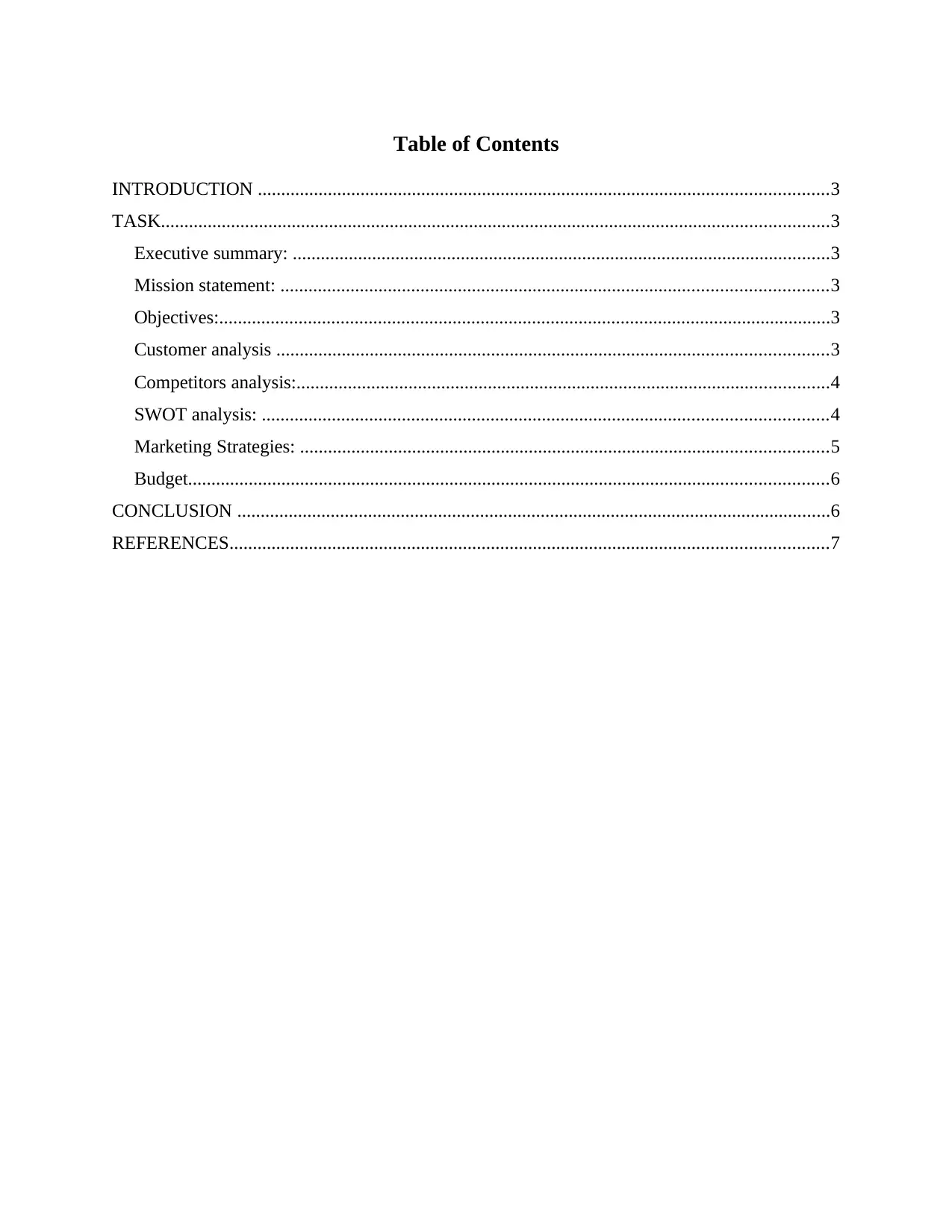
Table of Contents
INTRODUCTION ..........................................................................................................................3
TASK...............................................................................................................................................3
Executive summary: ...................................................................................................................3
Mission statement: .....................................................................................................................3
Objectives:...................................................................................................................................3
Customer analysis ......................................................................................................................3
Competitors analysis:..................................................................................................................4
SWOT analysis: .........................................................................................................................4
Marketing Strategies: .................................................................................................................5
Budget.........................................................................................................................................6
CONCLUSION ...............................................................................................................................6
REFERENCES................................................................................................................................7
INTRODUCTION ..........................................................................................................................3
TASK...............................................................................................................................................3
Executive summary: ...................................................................................................................3
Mission statement: .....................................................................................................................3
Objectives:...................................................................................................................................3
Customer analysis ......................................................................................................................3
Competitors analysis:..................................................................................................................4
SWOT analysis: .........................................................................................................................4
Marketing Strategies: .................................................................................................................5
Budget.........................................................................................................................................6
CONCLUSION ...............................................................................................................................6
REFERENCES................................................................................................................................7
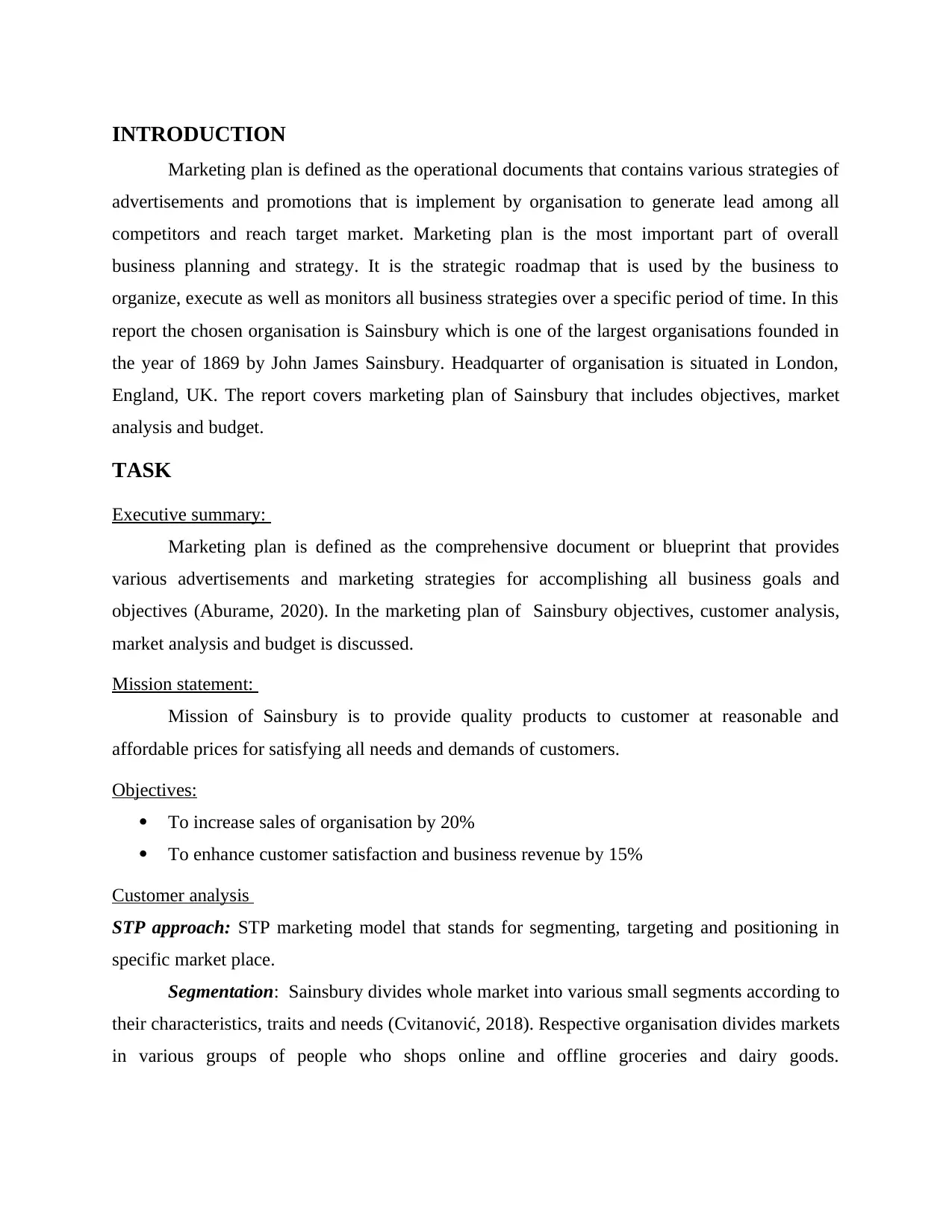
INTRODUCTION
Marketing plan is defined as the operational documents that contains various strategies of
advertisements and promotions that is implement by organisation to generate lead among all
competitors and reach target market. Marketing plan is the most important part of overall
business planning and strategy. It is the strategic roadmap that is used by the business to
organize, execute as well as monitors all business strategies over a specific period of time. In this
report the chosen organisation is Sainsbury which is one of the largest organisations founded in
the year of 1869 by John James Sainsbury. Headquarter of organisation is situated in London,
England, UK. The report covers marketing plan of Sainsbury that includes objectives, market
analysis and budget.
TASK
Executive summary:
Marketing plan is defined as the comprehensive document or blueprint that provides
various advertisements and marketing strategies for accomplishing all business goals and
objectives (Aburame, 2020). In the marketing plan of Sainsbury objectives, customer analysis,
market analysis and budget is discussed.
Mission statement:
Mission of Sainsbury is to provide quality products to customer at reasonable and
affordable prices for satisfying all needs and demands of customers.
Objectives:
To increase sales of organisation by 20%
To enhance customer satisfaction and business revenue by 15%
Customer analysis
STP approach: STP marketing model that stands for segmenting, targeting and positioning in
specific market place.
Segmentation: Sainsbury divides whole market into various small segments according to
their characteristics, traits and needs (Cvitanović, 2018). Respective organisation divides markets
in various groups of people who shops online and offline groceries and dairy goods.
Marketing plan is defined as the operational documents that contains various strategies of
advertisements and promotions that is implement by organisation to generate lead among all
competitors and reach target market. Marketing plan is the most important part of overall
business planning and strategy. It is the strategic roadmap that is used by the business to
organize, execute as well as monitors all business strategies over a specific period of time. In this
report the chosen organisation is Sainsbury which is one of the largest organisations founded in
the year of 1869 by John James Sainsbury. Headquarter of organisation is situated in London,
England, UK. The report covers marketing plan of Sainsbury that includes objectives, market
analysis and budget.
TASK
Executive summary:
Marketing plan is defined as the comprehensive document or blueprint that provides
various advertisements and marketing strategies for accomplishing all business goals and
objectives (Aburame, 2020). In the marketing plan of Sainsbury objectives, customer analysis,
market analysis and budget is discussed.
Mission statement:
Mission of Sainsbury is to provide quality products to customer at reasonable and
affordable prices for satisfying all needs and demands of customers.
Objectives:
To increase sales of organisation by 20%
To enhance customer satisfaction and business revenue by 15%
Customer analysis
STP approach: STP marketing model that stands for segmenting, targeting and positioning in
specific market place.
Segmentation: Sainsbury divides whole market into various small segments according to
their characteristics, traits and needs (Cvitanović, 2018). Respective organisation divides markets
in various groups of people who shops online and offline groceries and dairy goods.
⊘ This is a preview!⊘
Do you want full access?
Subscribe today to unlock all pages.

Trusted by 1+ million students worldwide
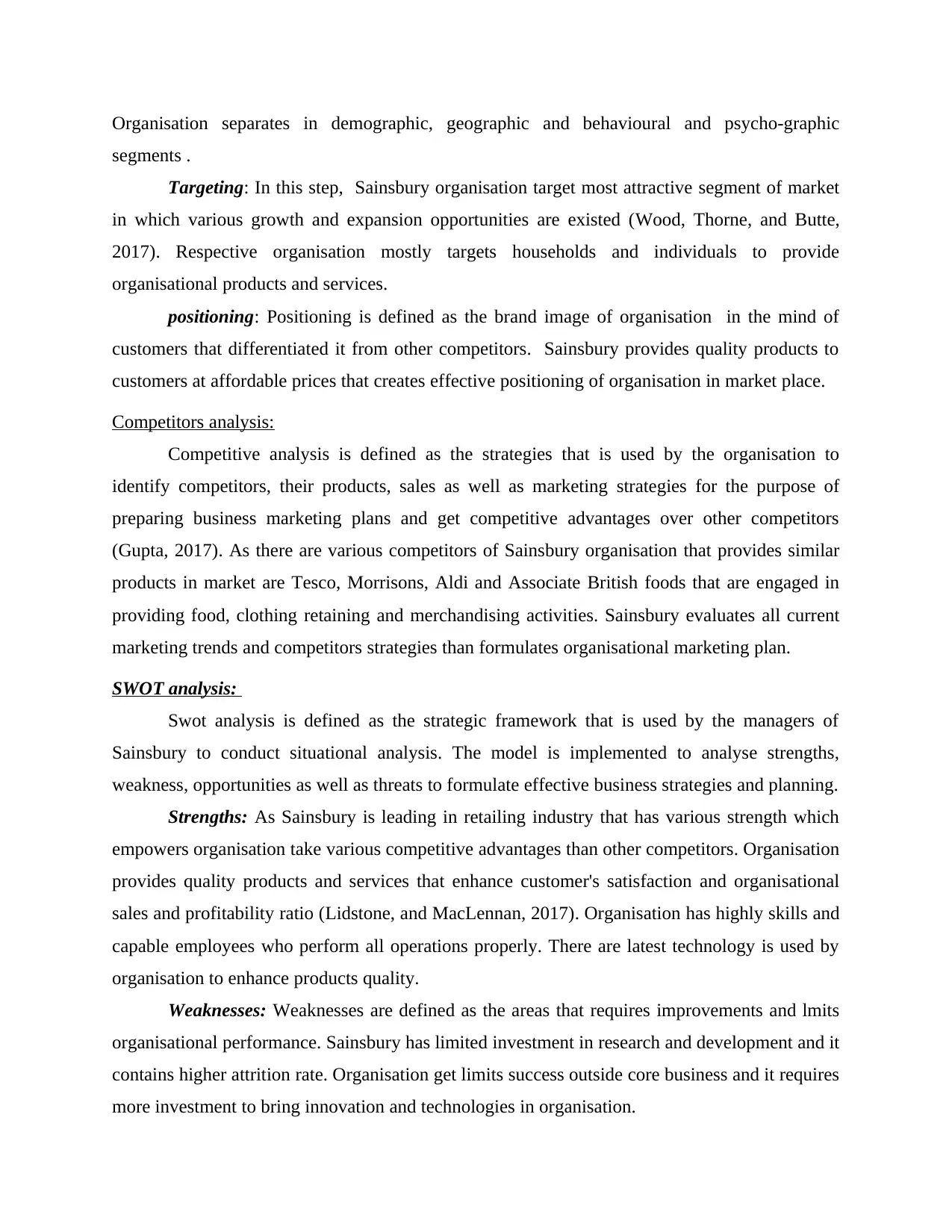
Organisation separates in demographic, geographic and behavioural and psycho-graphic
segments .
Targeting: In this step, Sainsbury organisation target most attractive segment of market
in which various growth and expansion opportunities are existed (Wood, Thorne, and Butte,
2017). Respective organisation mostly targets households and individuals to provide
organisational products and services.
positioning: Positioning is defined as the brand image of organisation in the mind of
customers that differentiated it from other competitors. Sainsbury provides quality products to
customers at affordable prices that creates effective positioning of organisation in market place.
Competitors analysis:
Competitive analysis is defined as the strategies that is used by the organisation to
identify competitors, their products, sales as well as marketing strategies for the purpose of
preparing business marketing plans and get competitive advantages over other competitors
(Gupta, 2017). As there are various competitors of Sainsbury organisation that provides similar
products in market are Tesco, Morrisons, Aldi and Associate British foods that are engaged in
providing food, clothing retaining and merchandising activities. Sainsbury evaluates all current
marketing trends and competitors strategies than formulates organisational marketing plan.
SWOT analysis:
Swot analysis is defined as the strategic framework that is used by the managers of
Sainsbury to conduct situational analysis. The model is implemented to analyse strengths,
weakness, opportunities as well as threats to formulate effective business strategies and planning.
Strengths: As Sainsbury is leading in retailing industry that has various strength which
empowers organisation take various competitive advantages than other competitors. Organisation
provides quality products and services that enhance customer's satisfaction and organisational
sales and profitability ratio (Lidstone, and MacLennan, 2017). Organisation has highly skills and
capable employees who perform all operations properly. There are latest technology is used by
organisation to enhance products quality.
Weaknesses: Weaknesses are defined as the areas that requires improvements and lmits
organisational performance. Sainsbury has limited investment in research and development and it
contains higher attrition rate. Organisation get limits success outside core business and it requires
more investment to bring innovation and technologies in organisation.
segments .
Targeting: In this step, Sainsbury organisation target most attractive segment of market
in which various growth and expansion opportunities are existed (Wood, Thorne, and Butte,
2017). Respective organisation mostly targets households and individuals to provide
organisational products and services.
positioning: Positioning is defined as the brand image of organisation in the mind of
customers that differentiated it from other competitors. Sainsbury provides quality products to
customers at affordable prices that creates effective positioning of organisation in market place.
Competitors analysis:
Competitive analysis is defined as the strategies that is used by the organisation to
identify competitors, their products, sales as well as marketing strategies for the purpose of
preparing business marketing plans and get competitive advantages over other competitors
(Gupta, 2017). As there are various competitors of Sainsbury organisation that provides similar
products in market are Tesco, Morrisons, Aldi and Associate British foods that are engaged in
providing food, clothing retaining and merchandising activities. Sainsbury evaluates all current
marketing trends and competitors strategies than formulates organisational marketing plan.
SWOT analysis:
Swot analysis is defined as the strategic framework that is used by the managers of
Sainsbury to conduct situational analysis. The model is implemented to analyse strengths,
weakness, opportunities as well as threats to formulate effective business strategies and planning.
Strengths: As Sainsbury is leading in retailing industry that has various strength which
empowers organisation take various competitive advantages than other competitors. Organisation
provides quality products and services that enhance customer's satisfaction and organisational
sales and profitability ratio (Lidstone, and MacLennan, 2017). Organisation has highly skills and
capable employees who perform all operations properly. There are latest technology is used by
organisation to enhance products quality.
Weaknesses: Weaknesses are defined as the areas that requires improvements and lmits
organisational performance. Sainsbury has limited investment in research and development and it
contains higher attrition rate. Organisation get limits success outside core business and it requires
more investment to bring innovation and technologies in organisation.
Paraphrase This Document
Need a fresh take? Get an instant paraphrase of this document with our AI Paraphraser
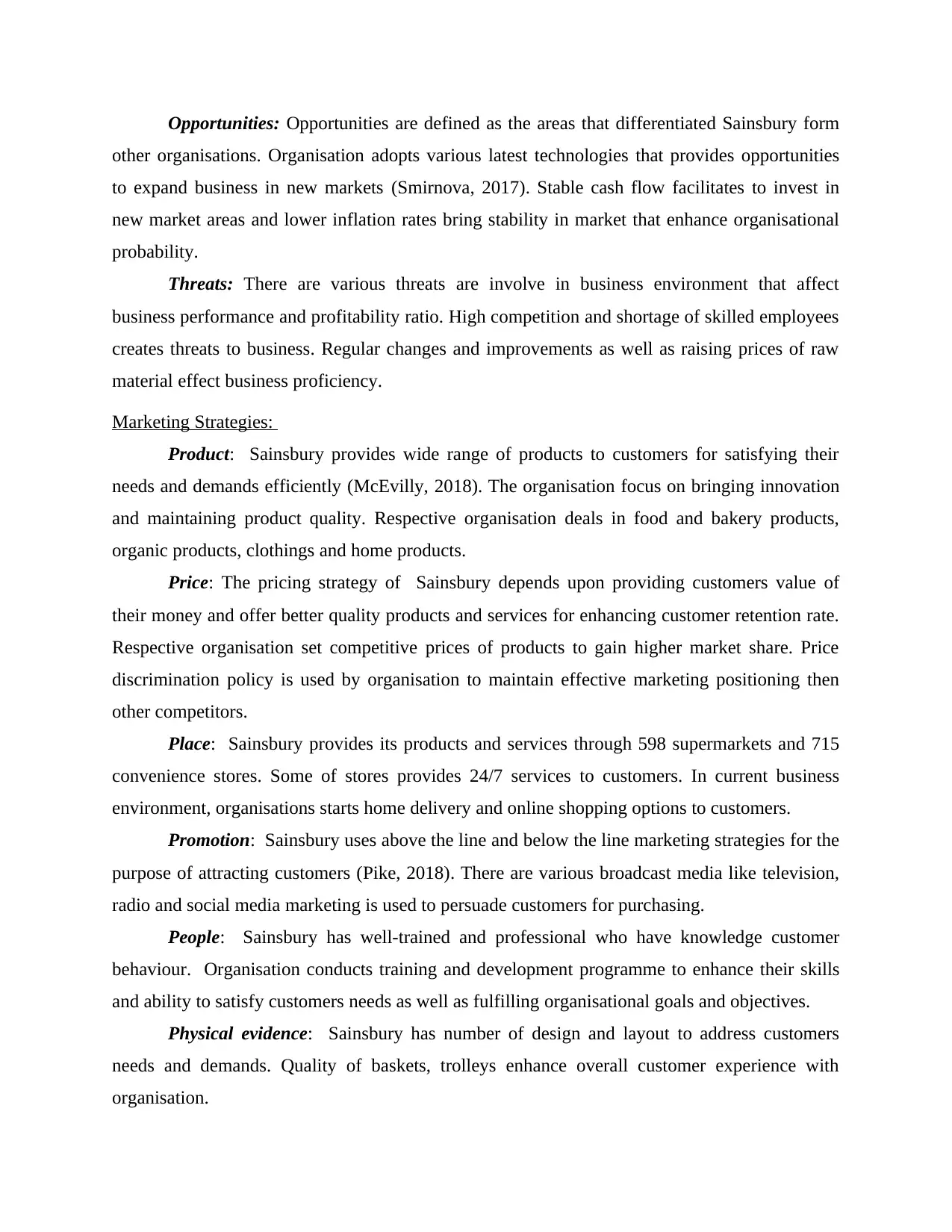
Opportunities: Opportunities are defined as the areas that differentiated Sainsbury form
other organisations. Organisation adopts various latest technologies that provides opportunities
to expand business in new markets (Smirnova, 2017). Stable cash flow facilitates to invest in
new market areas and lower inflation rates bring stability in market that enhance organisational
probability.
Threats: There are various threats are involve in business environment that affect
business performance and profitability ratio. High competition and shortage of skilled employees
creates threats to business. Regular changes and improvements as well as raising prices of raw
material effect business proficiency.
Marketing Strategies:
Product: Sainsbury provides wide range of products to customers for satisfying their
needs and demands efficiently (McEvilly, 2018). The organisation focus on bringing innovation
and maintaining product quality. Respective organisation deals in food and bakery products,
organic products, clothings and home products.
Price: The pricing strategy of Sainsbury depends upon providing customers value of
their money and offer better quality products and services for enhancing customer retention rate.
Respective organisation set competitive prices of products to gain higher market share. Price
discrimination policy is used by organisation to maintain effective marketing positioning then
other competitors.
Place: Sainsbury provides its products and services through 598 supermarkets and 715
convenience stores. Some of stores provides 24/7 services to customers. In current business
environment, organisations starts home delivery and online shopping options to customers.
Promotion: Sainsbury uses above the line and below the line marketing strategies for the
purpose of attracting customers (Pike, 2018). There are various broadcast media like television,
radio and social media marketing is used to persuade customers for purchasing.
People: Sainsbury has well-trained and professional who have knowledge customer
behaviour. Organisation conducts training and development programme to enhance their skills
and ability to satisfy customers needs as well as fulfilling organisational goals and objectives.
Physical evidence: Sainsbury has number of design and layout to address customers
needs and demands. Quality of baskets, trolleys enhance overall customer experience with
organisation.
other organisations. Organisation adopts various latest technologies that provides opportunities
to expand business in new markets (Smirnova, 2017). Stable cash flow facilitates to invest in
new market areas and lower inflation rates bring stability in market that enhance organisational
probability.
Threats: There are various threats are involve in business environment that affect
business performance and profitability ratio. High competition and shortage of skilled employees
creates threats to business. Regular changes and improvements as well as raising prices of raw
material effect business proficiency.
Marketing Strategies:
Product: Sainsbury provides wide range of products to customers for satisfying their
needs and demands efficiently (McEvilly, 2018). The organisation focus on bringing innovation
and maintaining product quality. Respective organisation deals in food and bakery products,
organic products, clothings and home products.
Price: The pricing strategy of Sainsbury depends upon providing customers value of
their money and offer better quality products and services for enhancing customer retention rate.
Respective organisation set competitive prices of products to gain higher market share. Price
discrimination policy is used by organisation to maintain effective marketing positioning then
other competitors.
Place: Sainsbury provides its products and services through 598 supermarkets and 715
convenience stores. Some of stores provides 24/7 services to customers. In current business
environment, organisations starts home delivery and online shopping options to customers.
Promotion: Sainsbury uses above the line and below the line marketing strategies for the
purpose of attracting customers (Pike, 2018). There are various broadcast media like television,
radio and social media marketing is used to persuade customers for purchasing.
People: Sainsbury has well-trained and professional who have knowledge customer
behaviour. Organisation conducts training and development programme to enhance their skills
and ability to satisfy customers needs as well as fulfilling organisational goals and objectives.
Physical evidence: Sainsbury has number of design and layout to address customers
needs and demands. Quality of baskets, trolleys enhance overall customer experience with
organisation.
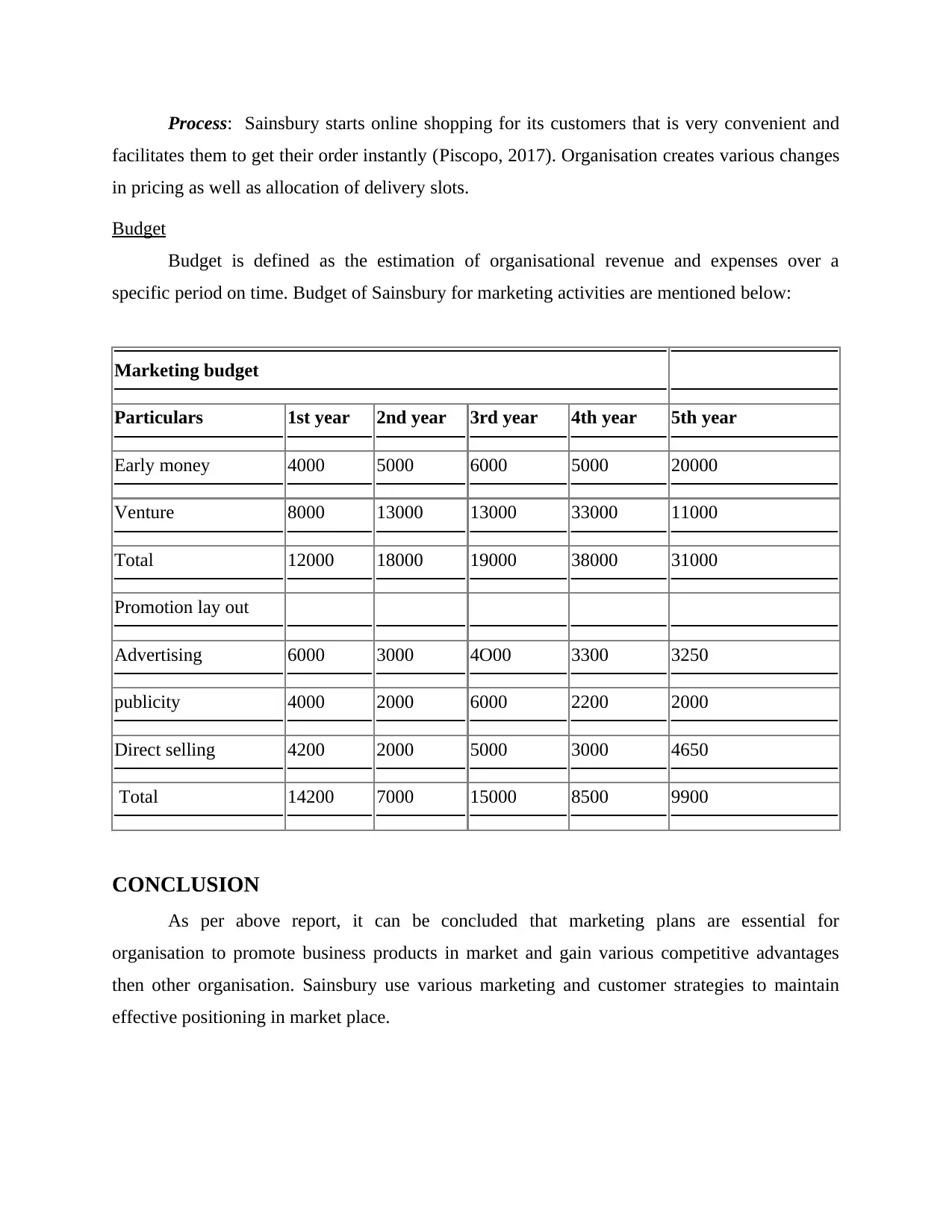
Process: Sainsbury starts online shopping for its customers that is very convenient and
facilitates them to get their order instantly (Piscopo, 2017). Organisation creates various changes
in pricing as well as allocation of delivery slots.
Budget
Budget is defined as the estimation of organisational revenue and expenses over a
specific period on time. Budget of Sainsbury for marketing activities are mentioned below:
Marketing budget
Particulars 1st year 2nd year 3rd year 4th year 5th year
Early money 4000 5000 6000 5000 20000
Venture 8000 13000 13000 33000 11000
Total 12000 18000 19000 38000 31000
Promotion lay out
Advertising 6000 3000 4O00 3300 3250
publicity 4000 2000 6000 2200 2000
Direct selling 4200 2000 5000 3000 4650
Total 14200 7000 15000 8500 9900
CONCLUSION
As per above report, it can be concluded that marketing plans are essential for
organisation to promote business products in market and gain various competitive advantages
then other organisation. Sainsbury use various marketing and customer strategies to maintain
effective positioning in market place.
facilitates them to get their order instantly (Piscopo, 2017). Organisation creates various changes
in pricing as well as allocation of delivery slots.
Budget
Budget is defined as the estimation of organisational revenue and expenses over a
specific period on time. Budget of Sainsbury for marketing activities are mentioned below:
Marketing budget
Particulars 1st year 2nd year 3rd year 4th year 5th year
Early money 4000 5000 6000 5000 20000
Venture 8000 13000 13000 33000 11000
Total 12000 18000 19000 38000 31000
Promotion lay out
Advertising 6000 3000 4O00 3300 3250
publicity 4000 2000 6000 2200 2000
Direct selling 4200 2000 5000 3000 4650
Total 14200 7000 15000 8500 9900
CONCLUSION
As per above report, it can be concluded that marketing plans are essential for
organisation to promote business products in market and gain various competitive advantages
then other organisation. Sainsbury use various marketing and customer strategies to maintain
effective positioning in market place.
⊘ This is a preview!⊘
Do you want full access?
Subscribe today to unlock all pages.

Trusted by 1+ million students worldwide

Paraphrase This Document
Need a fresh take? Get an instant paraphrase of this document with our AI Paraphraser
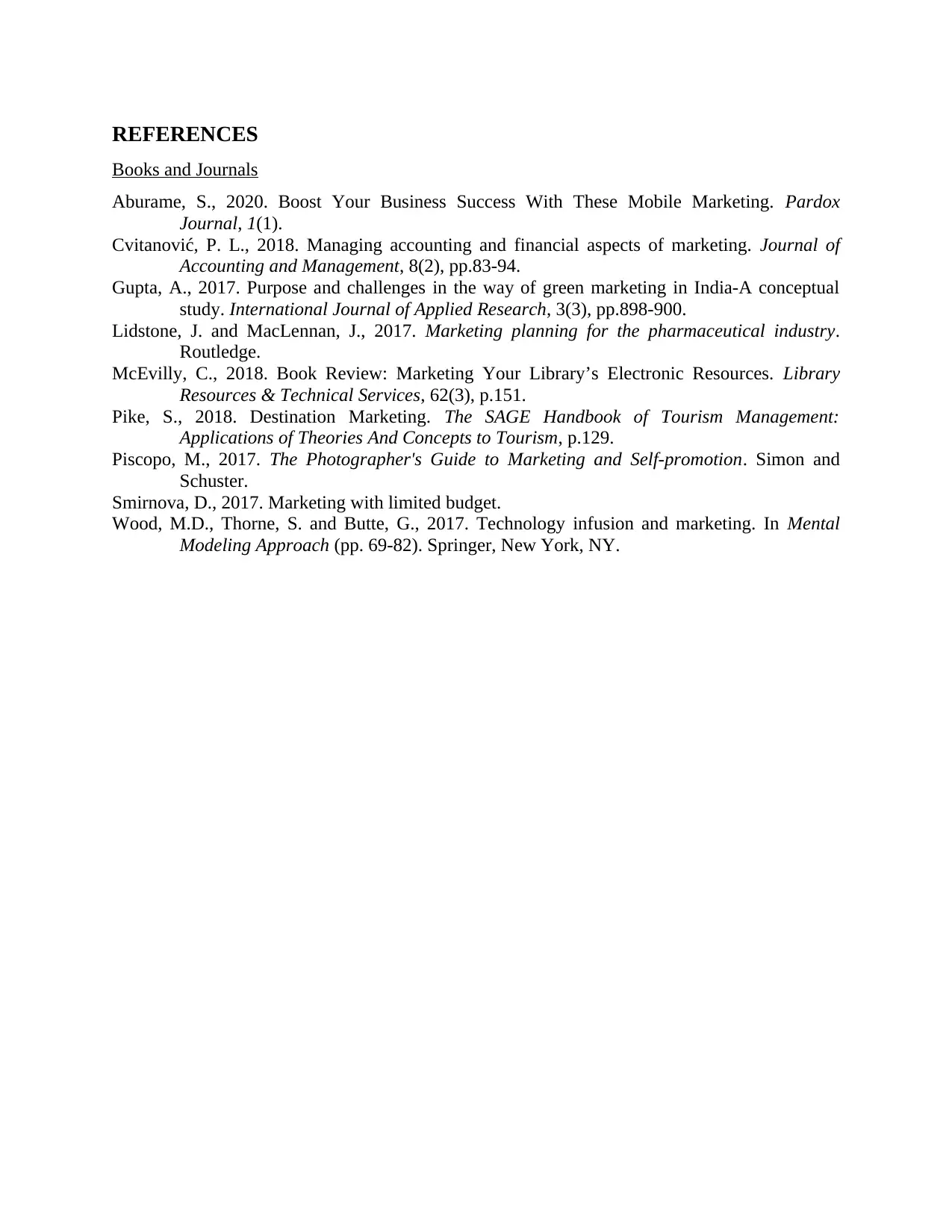
REFERENCES
Books and Journals
Aburame, S., 2020. Boost Your Business Success With These Mobile Marketing. Pardox
Journal, 1(1).
Cvitanović, P. L., 2018. Managing accounting and financial aspects of marketing. Journal of
Accounting and Management, 8(2), pp.83-94.
Gupta, A., 2017. Purpose and challenges in the way of green marketing in India-A conceptual
study. International Journal of Applied Research, 3(3), pp.898-900.
Lidstone, J. and MacLennan, J., 2017. Marketing planning for the pharmaceutical industry.
Routledge.
McEvilly, C., 2018. Book Review: Marketing Your Library’s Electronic Resources. Library
Resources & Technical Services, 62(3), p.151.
Pike, S., 2018. Destination Marketing. The SAGE Handbook of Tourism Management:
Applications of Theories And Concepts to Tourism, p.129.
Piscopo, M., 2017. The Photographer's Guide to Marketing and Self-promotion. Simon and
Schuster.
Smirnova, D., 2017. Marketing with limited budget.
Wood, M.D., Thorne, S. and Butte, G., 2017. Technology infusion and marketing. In Mental
Modeling Approach (pp. 69-82). Springer, New York, NY.
Books and Journals
Aburame, S., 2020. Boost Your Business Success With These Mobile Marketing. Pardox
Journal, 1(1).
Cvitanović, P. L., 2018. Managing accounting and financial aspects of marketing. Journal of
Accounting and Management, 8(2), pp.83-94.
Gupta, A., 2017. Purpose and challenges in the way of green marketing in India-A conceptual
study. International Journal of Applied Research, 3(3), pp.898-900.
Lidstone, J. and MacLennan, J., 2017. Marketing planning for the pharmaceutical industry.
Routledge.
McEvilly, C., 2018. Book Review: Marketing Your Library’s Electronic Resources. Library
Resources & Technical Services, 62(3), p.151.
Pike, S., 2018. Destination Marketing. The SAGE Handbook of Tourism Management:
Applications of Theories And Concepts to Tourism, p.129.
Piscopo, M., 2017. The Photographer's Guide to Marketing and Self-promotion. Simon and
Schuster.
Smirnova, D., 2017. Marketing with limited budget.
Wood, M.D., Thorne, S. and Butte, G., 2017. Technology infusion and marketing. In Mental
Modeling Approach (pp. 69-82). Springer, New York, NY.

⊘ This is a preview!⊘
Do you want full access?
Subscribe today to unlock all pages.

Trusted by 1+ million students worldwide

1 out of 10
Related Documents
Your All-in-One AI-Powered Toolkit for Academic Success.
+13062052269
info@desklib.com
Available 24*7 on WhatsApp / Email
![[object Object]](/_next/static/media/star-bottom.7253800d.svg)
Unlock your academic potential
Copyright © 2020–2025 A2Z Services. All Rights Reserved. Developed and managed by ZUCOL.



